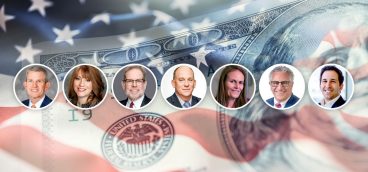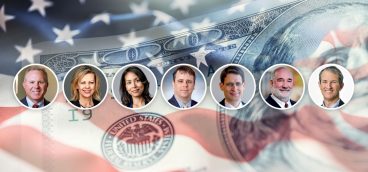Three Simple Questions

Each year in our Summer issue, we ask a group of the region’s leading financial experts to help our readers by responding to a question. This year, we’ve asked three. The first batch of the questions and answers follow.
Question 1: Since the election of Donald Trump, stock markets have soared and the confidence of consumers and investors has risen. How real is the Trump Bull Market and how should investors play it?
Thomas L. Wentling Jr., Wentling Tarquinio Loughney Wealth Consulting Group, UBS Financial Services Inc.: By traditional valuation metrics, this 8-year Bull Market, third longest since 1949, is pricey. Many economists that I respect believe Bull Markets don’t die of old age—they die of bad policy. Four things, and only four things, can derail the economy: restrictive monetary policy (nope), protectionist trade policy (yep), high and rising taxes (nope) and, finally, high and rising spending & regulation (nope). Three of four ain’t bad, and hopefully The Donald can be talked out of the worst of his trade protectionist spasms. Something big happened on November 8—for good or ill. The market is up 15 percent since then. As long as there is no material deterioration of these four factors, this Bull Market can grow even longer in the tooth.
James Armstrong, Henry H. Armstrong Associates: Proposals by politicians rarely become facts. And stock market movements are quixotic in the short term. Over the long term— the only timeframe that makes sense for stocks—stock prices will be driven by the profitability of the businesses they represent, not by political winds. So, today’s stock purchases should be guided by a realistic assessment of the profits that a given company can generate over the next 5 to 10 years. The wise investor will not be swayed by recent market trends, nor by political promises that may not come true.
Gregory J. Sorce, HBKS Wealth Advisors: The failure in the House of Representatives to pass health care reform has investors questioning whether President Trump’s pro-growth initiatives would be put off until 2018, or possibly never get passed in a fractured Congress. While economic data continues to improve, continued gridlock in Washington could hurt economic activity and presents the main risks for economic and stock market performance. This uncertainty could cause a short-term correction. Still, we believe it is wise to keep a longterm perspective and remain diversified in your investments. History has shown that it is very difficult to try to trade around market movements.
John Augustine, Huntington Bank: The successful stock investment areas post-election have been U.S. small- and mid-caps, financials, technology and industrials. In March, however, markets became restless about the prospects for President Trump’s 100-day agenda. The outperforming stock areas turned to overseas issues. We suspect this could be a soggy spring for stocks until the Trump administration reorganizes around repatriation, infrastructure and tax policy. If those initiatives are moved through Congress (which we give a 50 percent probability), we suspect it will be U.S. smalland mid-caps, industrials, financials and materials stocks that could benefit through a stormier summer. The key will be how the Fed reacts to all of this at its June and July meetings.
Gregory Curtis, Greycourt & Co.: Everyone was astonished when the markets took off after the Trump election. Having been bitten, investors now seem certain that the fate of the markets is inextricably intertwined with the fate of the new Administration. If Trump succeeds in reforming health care, reducing taxes, and building new infrastructure, all will be well. If not, the markets will crash. But this is wrong. The markets soared after the election because investors were relieved that they wouldn’t face four more years of businessunfriendly policies. But looking forward the markets will perform based on fundamentals, not on how well or poorly Trump might fare. Volatility will be high as Trump stumbles or succeeds, but the general direction of the market will proceed largely independent of his Administration.
Henry S. Beukema III, Guyasuta Investment Advisors: Since Nov. 8, the S&P 500 has rallied in anticipation of tax reform, a $1 trillion infrastructure program, deregulation and overall increased economic growth. If these legislative policies are not implemented or economic growth moderates, investors could begin to dial back expectations embedded in current security prices. Equity investors face a challenging environment: legislative/macroeconomic uncertainty, valuations that are not inexpensive and tightening Fed policies. With this backdrop, we recommend that investors own high quality stocks that can help protect capital in down markets and participate in bull markets. We seek companies that have sustainable free cash flow through the economic cycle, balance sheets with low levels of debt, strong management teams and competitive advantages/differentiation relative to their industry peers.
Michael R. Foster, BNY Mellon Wealth Management: The rising optimism of investors and business leaders have fueled the market rally in stocks out of anticipation that President Trump will deliver on his pro-growth and pro-business policies in a relatively short period of time. If these pro-growth initiatives come to fruition—though the timing is uncertain—stocks of cyclical companies will benefit the most as economic activity picks up in the U.S. and globally. However, at the end of the day, corporate earnings are the key driver of stock prices and companies with higher earnings growth and reasonable valuations will reward investors over time.
Find more answers to question 1 by reading “Three Simple Questions in the Markets, Part I” here.
Question 2: The Fed is working to “normalize” interest rates over the course of 2017. What impact will a more normal rate environment have on the stock and bond markets?
Robert Y. Kopf, Smithfield Trust Company: We feel that the Fed’s “normalization” is overdue and healthy. While the new rate environment will, of course, have a modestly negative effect on bond prices, I am convinced that the raising of interest rates will ultimately make bonds a more attractive asset class.
Mike Kauffelt, II, Bill Few Associates: What is normal? In my career, I’ve seen interest rates on CDs and mortgages from the high teens to almost zero. Getting rates on medium-term bonds in the 4–6 percent range might be considered normal, depending on where inflation is at the time. Oversimplifying, if rates on bonds were higher, the bond market would fall in price in the short term. Once rates are higher, there could be lower demand for higher yielding stocks many investors purchased in past years to gain yield not achievable from bonds. The biggest threat to our economy from normal rates might be the cost of servicing our national debt. Every time rates go up, the cost of interest payments to our creditors increases and, unfortunately, we have record U.S. debt levels.
Jack Kraus, Allegheny Financial: Generally, the Fed will increase rates when they have confidence that the economy is strong enough to absorb rate increases. If the economy is strong, the stock market should continue to perform based on how the underlying companies are doing and not by what the interest rates are doing. However, some sub-sectors that are most sensitive to rate increases may underperform. Each time the Fed raises rates, it is tapping its foot on the brakes of the economy. This should mean that inflation stays in control, which should mean a well-behaved bond market without longer rates spiking. If the Fed taps the brakes too hard, it could hurt the economy, which in turn could hurt the stock market. In addition, savers who have been hurt by the Fed’s policy of keeping short rates at or near zero (for eight-plus years) will finally receive some income on their savings as the Fed brings short-term rates up to a more historic level in relation to inflation.
Michael Lynn, Hampton Wealth Management: Contrary to common belief, a gradually rising interest rate environment coming off a record low interest rate environment with low inflation is actually considered good for the stock market and good for the economy. Interest rate normalization serves as a confirmation signal for returning health. The patient is no longer on life support, nor even in rehabilitation. However, like everything else in life, the reflationary play is good up to a point. Depending on the study, that line in the sand ranges from 4.5 to 5% on the 10-year Treasury note. At that distant transition point, CDs start to give stocks some serious competition, so returns will start to become more volatile, and further gains will be harder to come by.
Jeff Muhlenkamp, Muhlenkamp & Company: In the bond market, short-term rates will go up, long-term rates may not. I think the Japanese and European central bank bond buying programs will keep U.S. long rates abnormally low relative to inflation. Low rates inevitably prompt poor underwriting and eventually delinquencies and defaults rise. Lenders become worried about the return of their money, not the return on their money. Rolling over debt becomes more difficult, more expensive, or both for highly leveraged companies. At this point the corporate bond market and the stock market decline and treasuries rise. If the Fed gets aggressive, they can accelerate the timeline. If the Fed shrinks its balance sheet or Japanese and European central banks stop buying bonds, it will likely be a headwind for both markets.
Christopher Martin, Northwest Savings Bank: While the Fed is on track to raise the fed funds rate again in 2017, levels will not be back to what might be considered to be “normal” this year. The Federal Open Market Committee outlook is for a fed funds rate of around 3 percent over the long run, which likely wouldn’t be reached until 2019 at the earliest. As rates rise, the price of bonds falls, so as the Fed normalizes, we expect subpar returns out of fixed income. Over the long run, however, higher rates will have a positive impact on bond investors who’ve had significant difficulty in generating income over much of the past decade. Overall, the stock market has been helped by the low level of interest rates both in terms of low borrowing costs for companies and the lack of safe investment alternatives. In the near-term, even though rates are rising, they are still low by historical standards.
Question 3: If you had to put all your money in one asset class today and couldn’t sell for 10 years, what would you buy and why?
H. Scott Cunningham, PNC Wealth Management: Stocks—over 10 years, stocks consistently outperform other asset categories. In fact, historical data shows that stocks delivered positive returns 95 percent of the time when measured in 10-year increments. Stocks (broadly measured by the S&P 500®) returned a 10.0 percent annual average since 1926—and this includes the shocks of the Great Depression, the Great Recession, and all of world history for the past 90 years. The decades of the 1930s and 2000s were the only 10-year periods where stocks had negative total returns. Although stocks can be volatile, they typically recover and are followed by positive returns.
Linda Duessel, Federated Investors: Demographics are everything. And what they are showing us is baby boomers—the ’60s flower children who’ve shaped our society for generations—are retiring in droves. This argues for bigger entitlements for our already highly indebted country, lower productivity, weaker price-earnings multiples and midsingle- digit returns on stocks over the next 10 years. Bonds aren’t likely to do any better. So what to buy? Real estate, the other major asset class. Why? Demand. The baby boomers will be living into their 90s and will need all manner of housing—assisted living, independent living, group living, etc. And millennials— an even bigger demographic group that totals more than 80 million—will be coming into their own, getting married, forming households, having children… and buying homes.
Joseph Scarpo, Private Wealth Advisors: This question assumes that investors have similar needs, desires and risk tolerances. We do not. Any investor seeking superior long-term returns and willing to accept the volatility of the equity markets over shorter periods should participate in the stock markets. The stock markets of the world are the wealth creation engines that allow every individual investor to enjoy the benefits of an expanding global economy. Many investors seek the security of short-term loss avoidance. For those investors, market participation carries with it a level of unacceptable risk. Recognizing that investors have different needs, different objectives, and different risk tolerances leads to the natural conclusion that there is no right answer for every investor. The correct answer is build the long-term portfolio that is right for you.
Elizabeth Genter, Schenley Capital: If you’ve ever taken a long road trip, you’ll know that the path is unpredictable. We take the long-term view, as it is impossible to time the market. The U.S. is by far the world’s largest stock market and over the past 90 years the U.S. market has returned an average of 10 percent per annum from 1926–2016. The U.S. market is diversified with superior growth companies in every industry. The opportunity lies in one’s ability to select well managed, financially strong companies with low valuations. Investing in the U.S. stock market is a hedge against inflation; while inflation today is low, the possibility that high inflation will return is a concern. For these reasons, we would place all our money into large cap U.S. equities.
Peter F. Mathieson, Fairview Capital Investment Management: This is as difficult a question as can be but aptly illustrates the real life complexities we regularly work through with clients. In theory, we’d choose stocks for a decadelong holding period. Factors such demographics, business adaptability, and dividend growth make stocks more attractive over long timeframes. Also, 10 years should be sufficiently long enough to weather the episodic volatility inherent in stocks. In practice, it’s not that simple. If one has substantial near-term financial commitments—as I do with multiple college tuitions, for example—the calculus changes. It’s imperative that I be able to write those checks for at least the next three years, which is too short a time horizon to be 100 percent captive to the capricious market. Ask me again when my youngest of four graduates (hopefully) in 2020.





